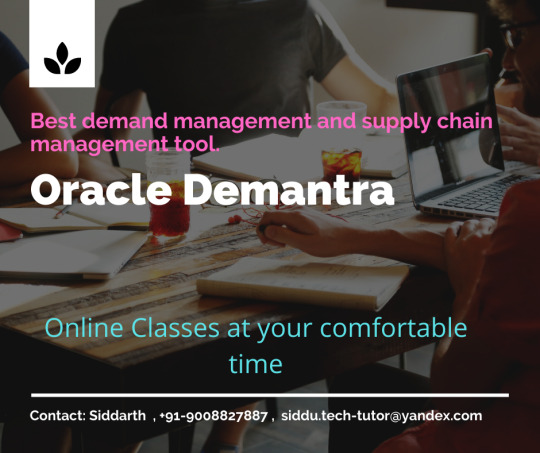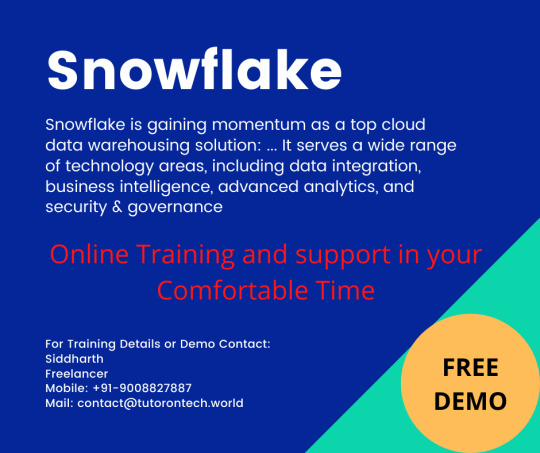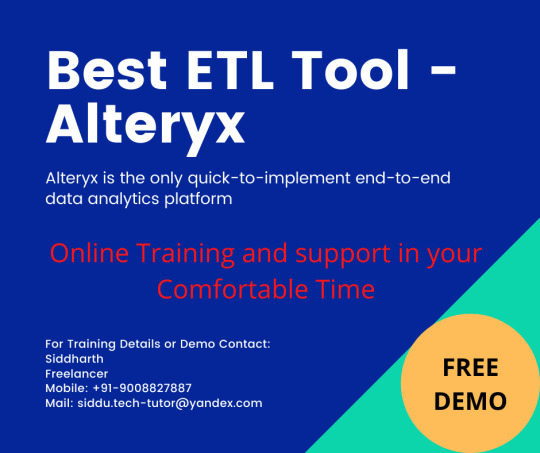Don't wanna be here? Send us removal request.
Photo

Salesforce Training and support
For Training Details or Demo Contact: Siddharth Mobile: +91-9008827887
0 notes
Photo

Anaplan Training & Support
For Training Details or Demo Contact: Siddharth Mobile: +91-9008827887
0 notes
Link
Okta connects any person with any application on any device. It's an enterprise-grade, identity management service, built for the cloud, but compatible with many on-premises applications. With Okta, IT can manage any employee's access to any application or device.
For More Details about OKTA online training feels free to contact.
· Name: Siddarth
· Email: [email protected]
· Ph: +919008827887(WhatsApp).
#oktaonlinetraining#oktatraining#oktaconsultants#oktatechnicalsupport#oktaprojectsupport#oktatutorial#oktamaterial#oktacourse
0 notes
Link
Alteryx is a business intelligence platform for data analysts that offers data mining and predictive analytics. It allows users to blend data from disparate sources, including Microsoft Excel, Hadoop, and Salesforce, with built-in drag-and-drop features to prepare raw data for analytics. The software provides a multi-deployment option that includes on-premise and SaaS (Software as a Service).
For More Details about Alteryx training feels free to contact.
· Name: Siddarth
· Email: [email protected]
· Ph: +919008827887(WhatsApp).
https://tutorontech.world/product.php?product=alteryx-training-and-support-tutorontech
#alteryxonlinetraining#alteryxtraining#alteryxonlineclass#alteryxconsultants#alteryxtutorial#alteryxtechnicalsupport
0 notes
Link
Course Content
❖ Snowflake Overview and key features
● Security and Data Protection
● Standard and Extended SQL Support
● Tools and Interfaces
● Connectivity
● Data Import and Export
● Data Sharing
● Database Replication and Failover
● Snowflake Overview
● Multi clustered shared Architecture
● Local region
● Availability zones
● Snowflake editions
● Standard
● Premier
● Enterprise
● Enterprise for sensitive data
● Virtual private snowflake
● Connectivity
● Data import and export
● Data sharing
● Data life cycle
● Continuous data protection
● Data encryption
● Parameters
● Data types
● SQL format models
● Object identifiers
● Information schema
❖ Snowflake Architecture
● Data storage
● Compute layer
● Storage layer
❖ Virtual warehouses in Snowflake
● Concept
● How to determine appropriate size
● Resizing or multi clustered VW to fix
● Snowflake credits
❖ Databases and Querying
● Databases
● Accessing databases
● Accessing database via roles
● Custom roles
● Querying
❖ Summary of Data Types
● Numeric Data Types
● String & Binary Data Types
● Logical Data Types
● Date & Time Data Types
● Semi-structured Data Types
❖ Data loading
● Data loading
● Staging
● Loading using SQL
● Loading using Web interface
❖ Demonstration
● Create warehouse
● Create database
● Create schema
● Create table
● Temporary Tables
● Transient Tables
● Permanent Tables
● Load table – ware house
● Load table – source files
● Load table – file format
● Load table – Load options
● Load table – Load results
● Query data – preview
● Query data – SQL query
● Query data – Export results
● Query data – SQL script
● Query data – Information schema
● Suspended Warehouse
● Drop ware house
● Drop table
● Drop schema
● Drop database
❖ Snowflake Overview and Architecture
● Snowflake procedures
● Task scheduling for snowflake procedures
❖ Snowflake Overview and Architecture
● Industries
● Traditional data warehousing
● Datawarehouse as a service
● Multi clustered shared architecture
● Data storage
● Compute layer
● Service layer
● Local region availability zones
● Cloning
● Time travel
● Snowflake editions
● When not to use snowflake
● Security and data protection
● Virtual warehouse in snowflake
● How to determine appropriate size
● Snowflake credits
❖ Snowflake Project explanation
● Project ● Roles and responsibilities
❖ Snowflake Resume preparation
❖ Snowflake Interview questions
#snowflakeonlinetraining#snowflaketutorial#snowflakeconsultants#snowflakematerials#snowflakejobsupport#snowflaketechnicalsupport#snowflakeprojectsupport
0 notes
Link
Veeva CRM-Intelligent engagement in the era of Precision medicine.
What is Veeva CRM?
Veeva is a CRM application built on the Salesforce platform designed specifically for the pharmaceutical and biotechnology industries. They are a leader in cloud-based software for the global life sciences industry. It helps pharma companies manage sales, control operations, and follow health industry regulations.
It helps pharma companies manage sales, control operations, and follow health industry regulations. Veeva CRM includes a data model, application logic, and a tailored user interface to support the pharmaceutical and biotechnology industries.
Committed to innovation, product excellence, and customer success, Veeva has more than 675 customers, ranging from the world's largest pharmaceutical companies to emerging biotechs.
Veeva CRM Benefits
· -Manage focused content and distribute it across multiple channels using a central hub.
· -Intuitive user interface based on actual web experiences.
· -Smart reports, dashboards for quick lookups, out-of-the-box solutions, and real-time insights help you to make better strategic and tactical decisions.
Main features of Veeva CRM are:
· Multichannel built in.
· Robust functionality.
· Speed & adaptability.
· One system for all.
· Continuous innovation.
· Pre-built integrations.
· Mobility.
· Extensibility.
Check out these Veeva products:
VBioPharma
iRep — CRM + CLM + iPad
VMobile Tablet
VMobile Blackberry
VMobile PDA
VMobile iPhoneetc
EEVA Advantages
· Veeva CRM is now the foundation on which the pharmaceutical industry is innovating its sales and marketing models for the future. Also, iRep has become the industry’s choice for CLM on the iPad.
· Only Veeva CRM accommodates the unique needs of multiple commercial teams in a single solution. It improves user adoption and sales effectiveness, while reducing cost and complexity.
· Veeva includes industry standardized healthcare professional (HCP), healthcare organization (HCO), and affiliate data for countries worldwide. This eliminates the need to subscribe to multiple external data sources.
For More Details about Veeva online training feels free to contact.
Name: Siddharth
Email: [email protected]
Ph: +919008827887(WhatsApp).
https://tutorontech.world/category.php?category=Veeva%20Courses
#veevacrmonlinetraining#veevacrmtraining#veevacrmtutorial#veevacrmcorporatetraining#veevacrmonlineclass
0 notes
Text
DevOps consulting, Training & support
DevOps is a set of practices that combines software development and IT operations. It aims to shorten the systems development life cycle and provide continuous delivery with high software quality.
The top 7 benefits of DevOps for CIOs
· Improved operational support and faster fixes.
· Good processes across IT and teams, including automation.
· Increased team flexibility and agility.
· Happier, more engaged teams.
· Cross-skilling and self-improvement.
· Collaborative working.
· Respect from senior management.
Here are the top five reasons why the industry has been so quick to adopt DevOps principles:
1. Shorter Development Cycles, Faster Innovation
2. Reduced Deployment Failures, Rollbacks, and Time to Recover
3. Improved Communication and Collaboration
4. Increased Efficiencies
5. Reduced Costs and IT Headcount
Final Thoughts
The industry has spoken, and it’s implementing DevOps at a rapid rate. Organizations are eager to take advantage of faster application delivery, enhanced innovation, more stable operating environments, and performance-focused employee teams.
Is DevOps a Good Career?
DevOps expertise is in high demand. Job postings with “DevOps” in a title or keyword are sprouting up everywhere. DevOps practitioners are among the highest paid people in IT, and it’s the number one most difficult tech job to fill.
DevOps emerged as a buzzword. But now, it looks like a legitimate course for infrastructural development. The percentage of businesses investing in DevOps rose from an already-impressive 66 percent in 2015 to 74 percent in 2016, and tools like Chef, Puppet, and Docker are home to massive user bases. Demand for skilled DevOps engineers is also rising.
According to GlassDoor, the average salary for a DevOps engineer is a juicy $100,000 per year. Yet even that isn’t enough to keep DevOps positions filled. According to a 2016 study by Indeed, DevOps engineers are the single hardest position for IT teams to keep filled.
DevOps will continue to grow in demand as:
More consumers and businesses rely on cloud software.
Businesses strive for higher efficiency.
Tech competition increases.
The Knowledge to learn Devops are:
1. knowledge about Unix/Linux commands and Command Line Interface.
2. A basic scripting language like python will be more useful for automation.
3. Basic knowledge about cloud platforms, like aws, azure, etc.
4. Java is helpful during the testing process.
what are business benefits of DevOps?
implementing DevOps best practices and workflows helps the businesses save time and money, increase software lifecycle predictability, build a corporate culture around innovation and keep motivation levels high. We will highlight it in the details below.
devops future scope in india
DevOps is the blazing career in INDIA. It has been listed as one of the top 10 technologies to learn 2020 for the past 5–8 years now. Startups such as PAYTM, OYO, LENSKART, ZOMATO, FLIPKART are all having a huge team of DevOps, TECHOPS, INFRAOPS, etc.
There are technical benefits:
Continuous software delivery
Less complexity to manage
Faster resolution of problems
DevOps expertise is in high demand. Job postings with “DevOps” in a title or keyword are sprouting up everywhere. DevOps practitioners are among the highest paid people in IT, and it’s the number one most difficult tech job to fill.
There are technical benefits:
Continuous software delivery
Less complexity to manage
Faster resolution of problems
The Knowledge to learn Devops are:
1. knowledge about Unix/Linux commands and Command Line Interface.
2. A basic scripting language like python will be more useful for automation.
3. Basic knowledge about cloud platforms, like aws, azure, etc.
4. Java is helpful during the testing process.
DevOps is the blazing career in INDIA. It has been listed as one of the top 10 technologies to learn 2020 for the past 5–8 years now. Startups such as PAYTM, OYO, LENSKART, ZOMATO, FLIPKART are all having a huge team of DevOps, TECHOPS, INFRAOPS, etc.
TutoronTech is a group of freelancers working on different trending Technologies. Our main Goal is to share our knowledge to those who are in need. We basically provide online trainings and Project supports.
DevOps emerged as a buzzword. But now, it looks like a legitimate course for infrastructural development. The percentage of businesses investing in DevOps rose from an already-impressive 66 percent in 2015 to 74 percent in 2016, and tools like Chef, Puppet, and Docker are home to massive user bases. Demand for skilled DevOps engineers is also rising.
According to GlassDoor, the average salary for a DevOps engineer is a juicy $100,000 per year. Yet even that isn’t enough to keep DevOps positions filled. According to a 2016 study by Indeed, DevOps engineers are the single hardest position for IT teams to keep filled.
DevOps will continue to grow in demand as:
· More consumers and businesses rely on cloud software.
· Businesses strive for higher efficiency.
· Tech competition increases.
what are business benefits of DevOps?
implementing DevOps best practices and workflows helps the businesses save time and money, increase software lifecycle predictability, build a corporate culture around innovation and keep motivation levels high. We will highlight it in the details below.
The industry has spoken, and it’s implementing DevOps at a rapid rate. Organizations are eager to take advantage of faster application delivery, enhanced innovation, more stable operating environments, and performance-focused employee teams.
TutoronTech is a group of freelancers working on different trending Technologies. Our main Goal is to share our knowledge to those who are in need. We basically provide online trainings and Project supports.
For Training Details or Demo Contact:
Siddharth
Mobile: +91-9008827887
Mail: [email protected]
https://tutorontech.world/product.php?product=devops-training-and-support
#devopsonlinetraining#devopstraining#devopsconsulting#devopstutorial#devopscourse#devopsintegration#devopsjobsupport#devopscertification#devopscorporatetraining
0 notes
Text
Oracle Process Manufacturing training & consulting
Oracle Process Manufacturing Training – Costing
The Oracle Process Manufacturing Process Execution application tracks firm planned orders and production batches from incoming materials through to finished goods. Seamlessly integrated to the Product Development application, Process Execution converts planned orders to single or multiple production batches, allocates ingredients, records actual ingredient usage, and completes and closes production batches. Production inquiries and preformatted reports help optimize inventory costs while maintaining a high level of customer satisfaction with on-time delivery of high quality products.
Using OPM Cost Management
Identifying the Cost Management Process Flow
Defining Cost Attributes
Defining Standard Costing
Defining Actual Costing
Defining Lot Costing
Performing Period-End Cost Processing
Identifying the Cost Management Process Flow
Reviewing Costing Setup
Defining Cost Types
Defining a Standard Cost Type
Defining an Actual Cost Type
Defining Cost Organization Associations
Defining Cost Factors
Defining Fiscal Policies
Defining Resources and Resource Costs
Describing Overheads
Defining Overhead Details
Defining Percentage Overhead Codes, Sources, and Targets
Defining Overhead Priorities and Variability's
Describing the Cost Management Process Flow
Describing Standard Cost
Describing the Standard Cost Flow
Defining Ingredient Costs
Defining Routings and Formulas
Defining Resources and Resource Cost
Defining Rollup Source Organizations
Running Cost Rollup
Deriving Product Cost
Viewing Product Costs
Viewing Formula Costs
Viewing Routing Costs
Viewing Overhead Costs
Describing Implementation Considerations
Describing the Cost Management Process Flow
Describing Actual Cost and the Actual Cost Flow
Describing Transactions in Actual Cost
Ensuring Accurate Actual Cost
Setting Up Material Cost Component Classes and Expense Allocations
Using Allocation Definition Types
Describing Raw Material Cost
Describing Cost Calculation Types
Describing Raw Material Cost Calculation Types
Describing Product Cost Calculation Types
Describing Overhead Costs
Describing Inventory Transfers
Running Actual Cost Process
Viewing Actual Costs
Adjusting Actual Costs
Describing Implementation Considerations
Describing the Cost Management Process Flow
Describing Lot Cost
Describing the Lot Cost Flow
Describing Transactions in Lot Cost
Setting Up a Lot Cost Type
Setting Up Lot Cost Items
Describing Lot Cost Calculations and Running the Lot Cost Process
Viewing Lot Cost History and Adjusting Lot Costs
Describing the Cost Management Process Flow
Describing the Standard Cost Period-End Processing Flow
Describing the Actual Cost Period-End Processing Flow
Describing the Lot Cost Period-End Processing
Describing the Cost Management Process Flow
Describing Copy Costs
Copying Item Costs
Copying Fixed Overheads
Modifying Existing Costs
Removing Existing Costs Before and During Copying
Copying Resource Costs
Copying Overhead Percentages and Source Organizations
Running and Interpreting the Item Cost Detail Report
Running and Interpreting the Actual Cost Adjustment Report
Running and Interpreting the GL Expense Allocation Definition Report
Running and Interpreting the GL Expense Allocation Detail Report
Running and Interpreting the Cost Organization Association Report
Running and Interpreting the GL Item Cost Detail Report
Running and Interpreting the OPM Lot Cost Detail, and Lot Cost History Reports
Running and Interpreting the Inventory Valuation Report
Introducing Cost Management APIs
Identifying Cost Management APIs
Calling the API
Performing Public API Validations
Using the Item Cost API
Using the Resource Cost API
Using the Allocation Definition API
Using the Overhead Details API
Describing Sub-ledger Accounting
Describing Application Accounting Definition Hierarchy
Using Multiple Sub-ledger Accounting Valuation for a Transaction
Describing Events
Describing Account Definitions
Running the OPM Accounting Pre-processor
Running Create Accounting
Transferring and Viewing GL Journal Entries
List the advantages of using Oracle Process Manufacturing (OPM) Process Execution
Identify tasks and responsibilities
Understand the process flow
Understand the inventory organization structure
Set up other applications for Process Execution
Set up parameters and profile options in Process Execution
Set up responsibilities and security profiles
Navigate OPM Process Execution using the standard menu and the hierarchical navigator workbench
Use the workbench
Use custom views
Describe firm planned orders (FPOs) and batches
Differentiate between FPOs and batches
Convert an FPO to a batch
Explain how to create FPOs and batches
Release and unrelease a batch
Cancel, reschedule, and reroute a batch and firm planned order
Complete a batch and revert a batch to WIP
Close and reopen a batch
Terminate a batch
Explain how Process Execution and MES are integrated
Create high and detailed level reservations
Understand the process of material movement on the shop floor
Understand material transactions and exceptions
Understand move orders and pending product lots
View inventory shortages
Scale a batch or FPO
Explain the Contribute to Yield indicator
Differentiate among scale types
Explain phantoms
Differentiate between automatically and manually exploding a phantom item
Create a phantom batch
Explain the advantages of batch step control
View batch step activities, resources, and resource transactions
Explain item step associations and batch step dependencies
Explain charges, activity factors, and process parameters
Explain the ingredient picking process
Explain how ingredient picking is integrated with Oracle Warehouse Management
Pick release a batch
Describe the Production Scheduler Workbench
Describe the Navigator and Gantt chart
View object properties
Reschedule batches, FPOs, and steps
Explain incremental backflushing
Explain consumption and yield type
Explain how actual quantities are calculated through backflushing
Perform incremental backflushing
Explain process loss and scrap
Explain the setup process for process loss and scrap percentages
Understand the process loss and scrap factor calculations
Identify Process Execution reports and inquiries
Run and view reports
Initiate inquiries
Run concurrent programs
List the Process Execution e-record and e-signature events
Explain creation and approval of events
For More Details about Oracle Process Manufacturing online training feels free to contact.
· Name: Siddarth
· Email: [email protected]
· Ph: +919008827887(WhatsApp).
https://tutorontech.world/product.php?product=oracle-process-manufacturing-training
#oracleprocessmanufacturingtraining#oracleprocessmanufacturingcorporatetraining#oracleprocessmanufacturingtutorial#oracleprocessmanufacturingonlineclass#oracleprocessmanufacturingconsultant#oracleprocessmanufacturingconsulting#oracleprocessmanufacturing
1 note
·
View note



